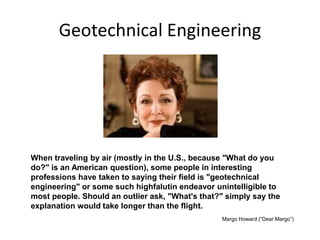4 Simple Techniques For Geotheta
4 Simple Techniques For Geotheta
Blog Article
The Only Guide to Geotheta
Table of Contents4 Easy Facts About Geotheta ExplainedThe Only Guide to GeothetaGeotheta Things To Know Before You BuyThe smart Trick of Geotheta That Nobody is Talking AboutThe 6-Minute Rule for Geotheta

They carry out site investigations, collect examples, perform research laboratory tests, and assess data to review the viability of the ground for building and construction jobs - Geo Tech Engineering. Based upon their findings, geotechnical engineers give suggestions for structure layout, incline security, preserving frameworks, and reduction of geotechnical risks. They collaborate with other specialists, such as architects, structural designers, and building and construction teams, to make certain that geotechnical considerations are integrated into the general task layout and implementation
By evaluating the habits and residential properties of soil and rock, they can determine possible geotechnical risks such as landslides, dirt negotiation, or incline instability. Their know-how assists stop failures or accidents that might jeopardize lives and property. Below are some detailed duties and responsibilities of a geotechnical designer: Website Examination: Geotechnical engineers conduct site investigations to gather data on subsurface conditions.
They translate the data to comprehend the buildings and behavior of the soil and rock, including their toughness, permeability, compaction attributes, and groundwater conditions. Geotechnical Analysis and Style: Geotechnical engineers analyze the data gathered during site examinations to analyze the stability and suitability of the website for construction jobs. They carry out geotechnical calculations and modeling to evaluate elements such as birthing capability, settlement, slope stability, side planet pressures, and groundwater flow.
Excitement About Geotheta
Foundation Style: Geotechnical engineers play an important function in creating foundations that can safely sustain the designated structure. They assess the dirt problems and tons requirements to establish the appropriate foundation type, such as shallow structures (e.g., grounds), deep foundations (e.g (https://hearthis.at/geotheta/set/geotheta/)., piles), or specialized techniques like dirt renovation. They think about elements such as settlement limits, bearing capability, and soil-structure communication to develop optimal foundation styles
They assess building plans, display website activities, and carry out field evaluations to verify that the style recommendations are adhered to. If unanticipated geotechnical concerns emerge, they analyze the scenario and give referrals for removal or modifications to the design. Risk Analysis and Reduction: Geotechnical engineers evaluate geotechnical risks and risks connected with the task website, such as landslides, liquefaction, or dirt disintegration.

Collaboration and Communication: Geotechnical designers function closely with other experts entailed in a job, such as architects, architectural engineers, and construction groups. Reliable communication and partnership are necessary to incorporate geotechnical considerations into the overall project layout and construction procedure. Geotechnical engineers give technical expertise, response queries, and make certain that geotechnical demands are fulfilled.
Geotheta for Beginners
Here are some kinds of geotechnical engineers: Structure Engineer: Foundation engineers focus on making and examining structures for frameworks. They examine the dirt conditions, load requirements, and site features to identify one of the most ideal foundation type and layout, such as shallow structures, deep structures, or specialized techniques like heap foundations.
They examine the elements influencing slope security, such as dirt residential properties, groundwater problems, and incline geometry, and create strategies to avoid incline failings and reduce dangers. Quake Engineer: Earthquake engineers concentrate on evaluating and developing structures to stand up to seismic forces. They examine the seismic danger of a website, examine soil liquefaction capacity, and establish seismic layout criteria to ensure the security and durability of structures during quakes.
They execute area screening, accumulate examples, and evaluate the accumulated information to define the dirt properties, geologic developments, and groundwater conditions at a site. Geotechnical Instrumentation Designer: Geotechnical instrumentation engineers concentrate on surveillance and determining the habits of dirt, rock, and structures. They set up and preserve instrumentation systems that keep track of factors such as soil negotiation, groundwater degrees, incline movements, and architectural variations to assess efficiency and give very early warnings of potential issues.
Geotheta Can Be Fun For Everyone
They perform tests such as triaxial examinations, combination examinations, straight shear tests, and leaks in the structure tests to collect data for geotechnical evaluation and design. Geosynthetics Designer: Geosynthetics engineers concentrate on the style and application of geosynthetic materials, such as geotextiles, geogrids, and geomembranes. They make use of these materials to boost dirt stability, reinforce slopes, offer drain options, weblink and control disintegration.
They have a tendency to be investigatory people, which means they're intellectual, introspective, and analytical. They are interested, systematic, sensible, logical, and sensible. Some of them are additionally social, meaning they're kind, charitable, participating, client, caring, handy, empathetic, tactful, and friendly - Engineer of Record.
In the office environment, geotechnical designers make use of specialized software devices to execute estimations, create designs, and analyze data. They prepare reports, testimonial project specifications, communicate with clients and staff member, and coordinate job activities. The office setup provides a conducive environment for study, evaluation, and partnership with other professionals associated with the project.
Some Known Factual Statements About Geotheta
They frequently see job sites to perform website investigations, assess geotechnical problems, and gather information for analysis. These brows through include taking a trip to different areas, sometimes in remote or tough terrains. Geotechnical designers may perform dirt tasting, conduct tests, and screen building activities to make sure that the geotechnical elements of the job are being executed properly.
Geotechnical designers also function in specialized geotechnical research laboratories. Geotechnical lab designers function extensively in these atmospheres, taking care of testing devices, running tools, and tape-recording information.
Report this page